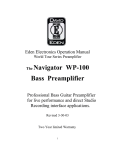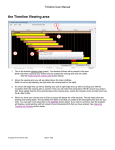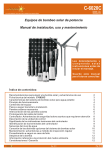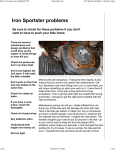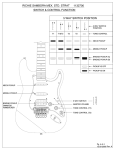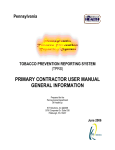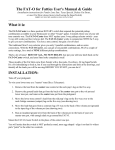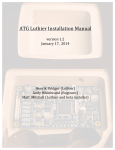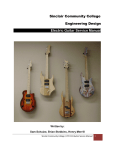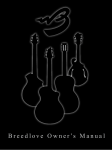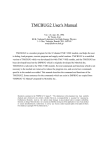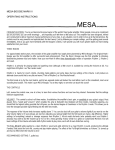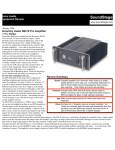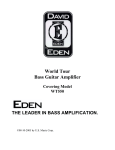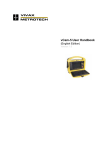Download Adrian Belew Signature Fly Manual
Transcript
Adrian Belew Signature Fly Owner’s Manual IMPORTANT! Before using your Parker Adrian Belew Signature Fly guitar please read these Safety Instructions. Although the design of this instrument has been extensively field tested by Adrian Belew, while on the road with King Crimson and other acts, it is important to remember that it has far more on-board electronics than any other guitar ever built, and should be treated with proper care & respect. 1. Please be VERY CAREFUL when installing new strings to pull them up and over the piezo bridge saddles when pushing them through the tremolo tailpiece. If you accidentally jam a string under a piezo saddle, there is a very good chance of breaking the connection to that transducer. Replacing a saddle is not something you would want to do while on the road! 2. Don’t force or jam the connectors or controls. If something doesn’t feel right or if you have any other concerns, show it to your technician sooner rather than later! 3. Avoid extremes of temperature, humidity, and vibration. 4. Check your shoulder straps, guitar stands, and other accessories routinely to be sure they are up to the job. 5. If you let others play or handle the instrument, be sure they understand the unique status and importance of this design before they take the wheel. 6. Don’t forget to turn the standby switch on the back cover OFF when you put the instrument away. Remove the 9 Volt battery if you’re not going to play it for a while. 7. Don’t let your Adrian Belew Signature Fly sit on the shelf or in a closet without being played occasionally. Like all fine instruments, this guitar is happiest when it is being played, and can only reach its full potential when being actively used. 2 | w w w . p a r k e r g u i t a r s . c om | Contents Introduction 4 Features 10 Specifications 11 What’s Included 12 Quickstart Checklist 13 Line 6 Variax® 14 Sustainiac Stealth Pro 15 RMC Piezo System 16 DiMarzio® Exclusive Humbucker 16 External Controls 17 Internal Controls 19 Power Supplies 21 Interface 22 Adrian’s Personal Setup 22 ® | w w w . p a r k e r g u i t a r s . c om | 3 Introduction Hello, I’m Adrian Belew. Thank you for purchasing the Adrian Belew Signature Edition Parker Fly. Sounds like a mouthful, but wait until you hear what this extraordinary guitar can do. We set out to make the most state-of-the-art electric guitar available. After nearly four years of effort by some of the best minds in the industry, I believe we made it. The real journey began even further back with the invention of what I consider to be the perfect instrument: the Parker Fly. Adolf Rickenbacker made something like an electric guitar as far back as 1931, but it was Leo Fender who in 1950 began producing his legendary guitars that would set the world on fire for electric guitars. So much so that two years later Gibson finally took the advice and design of a certain whiz kid and put out their own electric “Gibson Les Paul”. You could make a strong case that between these two designs, Fender and Gibson, all guitars since have been sired. Despite some basic flaws, these two designs reigned supreme for nearly fifty years; forever emulated but never truly improved upon. Until the Parker Fly. Ken Parker spent twenty-plus years designing the most radical ergonomic masterpiece sculpted to a lean four pounds of beautiful wood and created to resonate perfectly. The way to tell the virtues of an electric guitar is to play it unplugged to see how well it sustains. Along the way Ken solved 4 | w w w . p a r k e r g u i t a r s . c om | all the inherent problems (little things like tuning and intonation). My favorite part of a Parker Fly is the smooth, comfortable neck. It actually makes me play better. It would be impossible to have such a thin neck were it not for Ken’s revolutionary idea of coating the back of the guitar in a thin carbon and glass space-age composite. When baked into the wood the carbon composite gives the wood a tensile strength ten thousand times stronger. I don’t recommend it, but you could stand on this neck. Even better you can depend on it having no funny notes or dead spots whatsoever. Meaning perfect intonation. The fretboard is made of the same composite but improved by using stainless steel frets (another first) that never need replacing. As important as the feel of the neck is the tremolo. The tremolo allows phenomenal expression and has become an integral part of my sound. With the tremolo you shape and stretch the notes to give feeling to your playing. The Parker tremolo can be set for total freedom up and down in what is called “free-floating” mode. It has a sensuous spring to it but in fact it has no springs at all. Another revolutionary idea. When paired with Bob Sperzel’s brilliantly simple locking tuning keys (standard on Parkers) something remarkable happens: the guitar stays in tune! As one who nightly abuses the tremolo with reckless abandon, you can trust me on that. | w w w . p a r k e r g u i t a r s . c om | 5 The neck plays like butter, the tremolo is simply amazing, the body weighs a third of what most guitars weigh, and it stays perfectly in tune. Okay, but what about the sound? Wow! I’m glad I asked. Most Parkers come standard not only with gorgeous sounding magnetic pickups but with a bridge piezo pickup as well. The piezo pickup can be mixed with the magnetic pickup or played alone for acoustic guitar sounds, The sustain and juiciness of the sound is remarkable and can only be explained as “alive”. I have never played another guitar which can match the Parker for sustain. But even all of this wasn’t enough for yours truly. Why? There were a few applications the guitar still needed and they’re what make this AB model unique. The Adrian Belew Signature Edition Parker Fly is midi-compatible, meaning it can control any midi-based device. This allows the guitarist to step into the fabulous world of synthesizers, sampling, and modeling. By using RMC saddles the AB Parker gives each string a separate pickup. Now you are a keyboard player as well as guitarist. Over the years of modifying guitars to suit my needs something called the Sustainiac has become an absolute necessity. The neck pickup is a Sustainiac, the original design by Alan Hoover. In Sustainiac mode it allows two types of infinite sustain, a handy tool indeed. Since we were aiming for the most modern electric guitar we couldn’t leave out the Variax. The Line 6 Variax is an incredible new technology which gives the guitarist a wealth of tones unheard of by faithfully reproducing the sounds of 25 different vintage instruments. Les Pauls, Stratocasters, Telecasters, Rickenbacker 12-strings, Martin acoustics, Gretsch, Dobro, a plethora of Gibsons, you name it, the Variax even includes a Coral electric sitar and a Gibson banjo! All of which sound and react like the real thing. If you had a semi truck and an unlimited budget you could carry around all the expensive vintage instruments you now have access to with one knob on the AB Parker Fly. I chose 12-stage custom car paint finishes for my Parkers. They give off beautifully subtle color changes. Special attention was paid to keeping the sleek, modern, uncluttered look of a Parker Fly. In fact, the AB model has fewer knobs than a normal Parker. Just three knobs and a five-way selector controlling master volume, master tone, Sustainiac, and Variax. A remarkable feat of engineering which began with West Coast luthier Axel Rudich. 6 | w w w . p a r k e r g u i t a r s . c om | Axel Rudich (AR Guitar) To say that Axel Rudich was a master luthier doesn’t begin to express what he accomplished. He was the go-to guy for Parker mods, not just on the West Coast, but world-wide. His deep knowledge of electronics allowed him to venture where others wouldn’t dare, so when Adrian first started talking with Ken Parker about a revolutionary new instrument, it was only natural that Axel’s name came up. Starting with the state-of-the-art Parker Fly Deluxe, Axel added an intimidating list of features, then integrated the controls so that the technology is right at the player’s fingertips, inside the guitar itself. A key requirement was that the controls should be simple and intuitive. As anyone who has seen Adrian play these instruments on stage can attest, the results are nothing short of spectacular. After completing three prototypes however, Axel’s life was tragically cut short as a result of a car accident. For a time, all momentum was lost while Adrian and Parker Guitars thought about Axel’s contributions to the project, and to the music industry in general. | w w w . p a r k e r g u i t a r s . c om | 7 John Vitale (Parker Guitars Artist Relations) “Only days before Winter NAMM 2005 where we were to showcase and launch Adrian’s signature model, I received a phone call late at night from Axel. I could instantly hear in his voice something was very wrong. He was terribly disappointed that he would be unable to make the trip to Anaheim. A couple weeks later he had passed. The man was as much a pleasure to work with as he was a genius. I began the scramble to find someone who could pick up where Axel left off. During a meeting with Peter Swiadon of Roland and explaining the challenges ahead, Peter suggested I contact Dennis Anesi, who happened to live in Chicago. The rest as they say… is history. Enough cannot be said about the monumental task of reverse engineering what Axel had begun and then improving upon early designs and functionality. I believe in some way Axel sent Dennis to us. Managing this project and working with Adrian over the last four years has certainly been a highlight of my career. Many a meeting and long conversations with Adrian have produced the finest and most functional guitar in music today! My personal thanks go out to all the folks involved over the years to make this partnership and instrument a reality. The result is a truly unique signature artist guitar we are all very proud of.” Dennis Anesi (Ansan Precision) Meanwhile, audiences kept going to concerts, and fans kept buying music. After a number of false starts, John Vitale of Parker Guitars learned of a skilled luthier and machinist right in his own back yard who was already familiar with synth hookups, having done some internal GK installs for Peter Swiadon at Roland. His name is Dennis Anesi. With some help from long time associate Mark Stephens, Dennis has teamed up with Parker Guitars to replicate the exact configuration of Axel’s final prototype for a limited production run, which includes the instrument you now own. Here’s what Dennis has to say about the project. “All sorts of ‘signature’ guitars exist on the market. Most of them are nothing more than a special finish with a Duncan or DiMarzio pickup. Or something else on that order … with the artist’s name on it. But in this case, the consumer will end up with a guitar with specs by Adrian that was road-tested and refined with each of the prototypes. Although all the electronics are the same in the 3 protos, placement of controls and cable plug-in were moved around a bit. The third guitar, in arctic silver, got it exactly right. And the production run will be a duplicate of this guitar. Absolutely no features will be left out. This guitar will be exactly what Adrian plays with nothing deleted or cheapened in any way. The owner can relish on the fact that his axe has everything that Adrian’s has, without some ‘secret ingredient’ missing from the prototypes.” 8 | w w w . p a r k e r g u i t a r s . c om | The Parker Dream Team. John Vitale (left), Adrian Belew & Dennis Anesi at the 2009 NAMM Convention in Anaheim, CA. | w w w . p a r k e r g u i t a r s . c om | 9 Adrian Belew Signature Fly Features Solid 1 pc. Poplar Body 1 pc. Basswood Neck & Carbon Glass Carbon Glass Fretboard Stainless Steel Frets Parker® Vibrato Bridge Sperzel® Trim-Lok™ Tuners Sustainiac® Stealth PRO Neck Pickup Line 6 Variax® Modeling Component DiMarzio® Exclusive Humbucker RMC® Pow’r Bridge Saddles RMC® Poly-Drive 1 Preamp 13-pin GK-style connector for synth access 1/4” magnetic pickup tuner courtesy output jack 10 | w w w . p a r k e r g u i t a r s . c om | Overview RMC Piezo System A set of six RMC piezo transducers installed on the guitar’s bridge provides the signals that, processed by the RMC Poly-Drive I board, drive guitar synths or VG units connected to the guitar’s 13-pin output. Also, RMC’s acoustic mix is available. Line 6 Variax® Modeling Component All models and pickup options found on the original Variax guitars are available thru the rotary model selector switch (10 of its positions each offer 5 distinct sounds, plus two user-definable program banks each of which can hold 5 user-definable programs), 5-way switch and rotary tone control. Please refer to the Line 6 Variax® user manual for more information. Sustainiac® Stealth PRO Neck Pickup Sustainiac’s Stealth Pro sustainer provides infinite sustain in two modes (fundamental and harmonic); the Sustainiac driver functions as a neck pickup when the sustainer is off. Onboard Controls 12-position rotary switch with push-pull action selects between the 10 Variax model groups; when pushed, the Variax models are found at the guitar’s output; when pulled, the magnetic and piezo signals are at the output. 5-way Selector Switch Selects the different Variax models within each group; when the rotary model selector is pulled up, the 5-way switch selects between the Sustainiac driver (in its pickup mode), the RMC piezo ‘acoustic mix’ and the DiMarzio humbucker. Volume Control Affects the Variax models and the magnetic/piezo pickups. Tone Control With Push/Pull Action Affects the Variax models and the DiMarzio magnetic pickup; when pulled, it activates the Sustainiac sustainer; when rotated fully clockwise, it switches the Sustainiac from fundamental to harmonic mode. Line 6 Variax® Programming Button (in back) Programs custom model selections. | w w w . p a r k e r g u i t a r s . c om | 11 What’s Included The Adrian Belew Signature Fly guitar is an advanced technology system, and a valuable collector’s item. As such we would encourage you to keep all items together as a single set. Here’s a list of what’s included: Instrument A Parker Fly Deluxe guitar specially modified to match all features and specifications of the third & final prototype developed by Adrian Belew & Axel Rudich. Variax Power Regulator Custom built Power Regulator sends +8 VDC down pin-9 on the 13-pin synth cable, required to power up the Variax module. Comes with Line 6 standard 2 Amp, 9 VAC transformer set up for U.S. mains power (110 VAC, 60 Hz). Transformers for all other parts of the world can be obtained directly from Line 6. The Power Regulator will work with all Line 6 transformers, given that you have the correct model for the country you are in. Line 6 Standard 2 Amp, 9VAC transformer Standard Line 6 phantom power transformer . Case Parker Fly Deluxe case, just like Adrian uses. Manuals This manual, the Line 6 Variax Pilot’s Handbook, and the Parker Guitars Fly Deluxe manual. Cables & Adapters The Power Regulator has an attached 13-pin cable which connects to your guitar synthesizer. Certificate of Authenticity Official document from Parker Guitars, verifies the provenance of this instrument. 12 | w w w . p a r k e r g u i t a r s . c om | Quick Start Checklist Here is a checklist of things you need to do before playing the Adrian Belew Signature Guitar 1. Install a fresh 9 Volt Alkaline battery in the compartment on rear cover of instrument. 2. Start with the volume & tone controls on the guitar pushed in and turned counterclockwise and the Variax knob in the up position. Be sure gain is down on all other controls in your system. 3. Connect the Adrian Belew Signature Fly guitar to the supplied Power Regulator with a 13-pin MIDI instrument cable. (13-pin cable not included). 4. Connect the included Power Regulator to your guitar synthesizer using the attached 13-pin cable. NOTE CAREFULLY: the Power Regulator input and Power Regulator output use the same style connector, and could be interchanged if you don’t pay attention. Getting these backwards could damage the instrument, the Power Regulator, your synthesizer, or all three. Please be careful! 5. Plug the Line 6 power transformer into the Power Regulator AC input jack. 6. Plug the Line 6 power transformer line cord into a 110 VAC wall outlet. 7. Check that the synthesizer output and the guitar through output are both connected. If using guitar amplifiers, you’ll need two 1/4” cables. If using a mixing or recording console, you’ll need two direct interface (DI) boxes and XLR cables. 8. We recommend you use a volume pedal connected inline with the synthesizer output. 9. Switch the Sustainiac Standby switch on rear cover of instrument to the ON position. Be sure the green LED in the switch slider lights up. 10. Turn on power to synthesizer and any other outboard equipment, working your way towards the amplifiers or mixing console. 11. Bring gain up slowly while strumming the guitar. | w w w . p a r k e r g u i t a r s . c om | 13 Line 6 Variax® Modeling Component The Adrian Belew Signature Fly includes a complete Variax guitar modeling system from Line 6. This DSP (Digital Signal Processing) engine implements sonic models of dozens of famous guitars, grouped into ten families chosen by the Model Select rotary knob. Specific variations within each family are chosen with the Pickup Selector 5-position switch. For more details, please refer to the Line 6 Variax User’s Manual, included with your guitar. Note that in a typical Variax installation, pulling up on the Model Select knob enables custom model programming. This function has been moved to a pushbutton switch accessible in a recess near the Sustainiac Standby Switch on the back cover of your instrument. So wherever the Variax Manual says “pull up on the Model Select Knob,” you should instead press and hold the push-button switch on the back cover. Pulling up on the Model Select Knob of your Artist Edition Fly guitar actually turns off the Variax, putting the instrument into mag/piezo mode, with the Pickup Selector 5-position switch controlling the mag and piezo pickups. Also, the Variax Manual mentions using battery power or footswitch power. Neither of these options are installed on your instrument, so you should always use the Artist Edition Power Regulator connected to AC power when using Variax functions. Push Down: Variax Mode Pull Up: Mag/Piezo Mode 14 | w w w . p a r k e r g u i t a r s . c om | Sustainiac® Stealth Pro The pickup in the neck position of the Adrian Belew Signature Fly guitar is actually a Sustainiac® Stealth Pro infinite sustain driver. When the sustain function is engaged by pulling up on the Tone Knob, any individual note that you play can be held indefinitely, without decaying. While in the up position, turn the Tone Control Knob fully clockwise, past the detent, to switch the Sustainiac into Harmonic Mode. When sustain is disengaged by pushing the Tone Control Knob back in, the sustain driver functions as a normal neck pickup, chosen by the Pickup Selector 5-position switch. Note that the neck pickup/sustain driver is only active when the Standby Mode Switch on the back cover of the instrument is turned on. Pull Up: Sustain Mode Tone Knob Push Down: Normal Rotate Clockwise in UP position: Harmonic Mode | w w w . p a r k e r g u i t a r s . c om | 15 RMC® Poly Drive 1 Preamp & Pow’r Bridge Saddles Individual piezoelectric pickups are mounted on each bridge saddle on the Adrian Belew Signature Fly guitar. The signals are boosted and equalized by an on-board RMC PolyDrive I Preamp. Individual piezo signals from each string are made available to the Variax Guitar Modeling System, and to your polyphonic guitar synthesizer through the 13-pin connector. A mono mix of the piezo signals is also available on the Pickup Selector 5-position switch when the instrument is in “mag/piezo” mode. DiMarzio® Exclusive Humbucker Mounted in the bridge position, the DiMarzio humbucking pickup is connected directly to the 1/4” courtesy output jack (for connection to a strobe tuner) and to the RMC PolyDrive I Preamp, where the mag signal is amplified and equalized. This signal is then available on the Pickup Selector 5-position switch when the instrument is in “mag/piezo” mode. 16 | w w w . p a r k e r g u i t a r s . c om | External Controls Position #5 Position #4 Position #3 Position #2 Position #1 5-way Selector Switch To obtain maximum functionality, the controls on the Artist Edition Fly have been given multiple functions. This may seem confusing at first, but after playing the instrument for a while you will quickly become accustomed to the same simplicity and flexibility that Adrian Belew enjoys while on tour. Operation is further simplified by on-board active electronics, which serve to minimize the interaction between controls. A. Volume Knob A B. B Tone Knob C. Variax Model Knob C Volume Control The Volume Control knob controls both the Variax and the mag/piezo signals, which are available at the “mag pickup” output of your synthesizer. It does not control the volume of your synthesizer output, so you’ll want to have a separate volume foot pedal (not included) for balancing the synth volume against the other outputs. Tone Control The Tone Control knob controls both the Variax guitar models and the DiMarzio magnetic bridge pickup tone. This knob has two additional functions related to sustain mode. Pull up on the Tone Knob to engage the Sustainiac Stealth Plus infinite sustain mode. Turn the Tone Knob fully clockwise past the detent to select Sustainiac harmonic mode, which sends the sustained note up an octave. Note that when sustain mode is engaged, the neck pickup functions as the sustain driver, so no neck signal is available at the mag/piezo output. You must disengage sustain mode to get back the neck pickup signal. Otherwise, sustain mode will operate with all outputs, including Variax, synth, and mag/piezo. The sustainer is most effective in mag/piezo mode. | w w w . p a r k e r g u i t a r s . c om | 17 Line 6 Variax® Modeling Control Pull up on the Line 6 Variax® Model Control knob to disable the Variax and select mag/piezo mode. Push the Model Knob back down to enable the Variax Modeling System. Rotate the Model Knob to select a family of guitar models, then choose a specific model with the Pickup Selector 5-position switch (see below). 5-Way Pickup Selector Switch In Variax mode, this control selects individual guitar models within model groups. See the Variax User’s Manual for more information. In mag/piezo mode, this control has the following five positions: Position # 1. Mag bridge pickup alone Position # 2. Mag bridge & piezo pickups together Position # 3. Piezo pickup alone Position # 4. Mag neck & piezo pickups together Position # 5. Mag neck pickup alone This control has no effect on the synth output, or on the 1/4” tuner courtesy output. Sustainiac Standby Switch Whether using the Sustainiac Driver in the neck position for infinite sustain or as a magnetic pickup, you must first put the Sustainiac module in standby mode, by turning on the standby switch on the rear cover of the guitar. When standby mode is on, you should see a green LED visible in the switch slider. If you don’t see the green LED, then the on-board 9V battery is either worn out or missing and should be replaced. The standby switch must always be on for the mag/piezo functions to operate properly. According to the Maniac Music web site, current drain in standby mode is 3 to 5 mA, or about 100 hours of battery life with a standard alkaline battery. Current drain with infinite sustain engaged is considerably more, from 40 to 60 mA, or from 10 to 5 hours of battery life depending on which notes you are sustaining. Harmonic mode draws slightly less current. These numbers are not hard-and-fast, and may vary depending on your playing style, what brand of battery you buy, ambient temperature while playing, and other factors. Note that Maniac Music recommends that you use only alkaline 9 Volt batteries in this application. Ni-cads in particular don’t have enough initial voltage for proper sustain. Always keep a fresh battery in a sealed package on hand, so you can install it before going on stage to perform. 18 | w w w . p a r k e r g u i t a r s . c om | Internal Controls Your Adrian Belew Signature Fly guitar has a number of adjustments, which allow you or your technician to balance the internal signals. These have been preset at the factory to match Adrian’s preferred settings, but can also be adjusted to match your personal style. These are singleturn potentiometers, which require a flat-blade jeweler’s screwdriver for adjustment. Variax Program Button The Variax Modeling System has a feature that lets you customize the models stored in two of the model families. The programming button that does this is accessible in a recess on the rear cover of the instrument, without removing it. This control is meant to be relatively easy to use in rehearsal, when you have the manuals open in front of you, but probably shouldn’t be used while performing on stage. Note that the button must be held in during programming. To build a custom guitar setting you would carry out the following steps: 1. Select the desired sound by using the Model Select Knob and Pickup Selector. 2. Press and hold the programming button on the back cover to start the Save process. 3. Flick the Pickup Selector to the position you want to save your sound to. (Moving the Pickup Selector while you’re saving won’t change the sound, only the save location.) 4. Rotate the Model Select Knob to the custom bank of your choice (Custom 1, or Custom 2, at opposite ends of the dial). 5. Release programming button Volume Preset Trimpots There is a circuit module with three trimpots mounted inside the body cavity, which are accessible without removing the back cover through three adjacent holes. The holes are marked as “N”, “P”, and “B” to indicate “Neck”, “Piezo”, and “Bridge” control. These trimpots set the balance between the three mag/piezo signals before they are routed to the Pickup Selector 5-position switch. From left-to-right (guitar neck on your left) they control gain for the Sustainiac driver in the neck position (when in pickup mode) “N”, the RMC piezo pickups mono mix “P”, and the DiMarzio magnetic pickup in bridge position “B”. These controls are preset at the factory, but you should feel free to adjust them to suit your personal style. Note that since the Variax output is fixed, you should use the Variax as a reference level for balancing the trimpots. | w w w . p a r k e r g u i t a r s . c om | 19 Volume Preset Trimpots Variax Programming Button Sustainiac Standby Switch Sustainiac Stealth Plus Module Sustainiac Driver Sustainiac Pickup Pickup Selector 5-position Switch Neck Mag Master Volume Control Bridge Piezo Bridge Mag 6 Piezo Saddles RMC PolyDrive1 Preamp 6 Variax Modeling System Mode Switch 13 Pin Output Conn. 6 DiMarzio Pickup To Power Supply and Synthesizer Adrian Belew Signature Fly - Block Diagram 20 | w w w . p a r k e r g u i t a r s . c om 13 | Power Supplies Three separate power supplies are used when operating the Adrian Belew Signature Fly guitar. They are well isolated from each other, and as such you can play the instrument with one or more supplies missing, given that the functionality powered by that supply will be missing as well. All three are required to obtain full functionality from the instrument. The 1/4” courtesy output will always operate a strobe tuner or similar device, with or without power supplies. +/- 7 VDC This bipolar (both polarities) supply comes from your synthesizer through the 13-pin cable, and powers the RMC PolyDrive I Preamp. All synthesizers conforming to the GK standard should be able to provide this power through the 13-pin cable. The PolyDrive must be operating to get an output from your synthesizer, as well as the Variax, piezo, and DiMarzio mag pickups. 8 VDC This unipolar (single polarity) supply comes from the included Power Regulator through the 13-pin cable, and powers the Variax module. This supply is delivered through pin 9 of the 13-pin connector, which is otherwise unused. Only the Variax output is affected by this supply. If the Power Regulator is unavailable, you can still operate the guitar by plugging the 13-pin cable directly from guitar to synthesizer, but in this case the Variax will be inoperative. 9 VDC This unipolar (single polarity) supply comes from an on-board 9 Volt battery, and powers the Sustainiac Plus module. Using a battery isolates the sustain driver from the other circuits, allowing a smooth clean sustain sound. This battery is also required when using the Sustainiac Driver as a magnetic pickup in the neck position. | w w w . p a r k e r g u i t a r s . c om | 21 Interface Signals from your Adrian Belew Signature Fly are available in two forms. 1/4” Courtesy Output This mono phone jack brings out a signal directly from the DiMarzio magnetic pickup in the bridge position. Its only intended use is to connect a strobe tuner before going on stage. None of the guitar’s controls operate on this signal, and it includes none of the advanced features available in the instrument. It should not be used for performing, although at informal rehearsals you may find it satisfactory when connected to a small practice amp. 13-pin Synthesizer Output This is the main output of the instrument. All of the guitar’s controls operate on this output, and all of the advanced functions are available here. Adrian’s Personal Setup Here’s what Adrian had to say about his personal setup preferences: String Gauges “I use a super light top/regular bottom gauge of strings.” Neck “I like the action normal, not too high or too low.” Bridge “Very importantly I keep the trem in free-floating mode which allows me to bend up a third and down as far as I like.” Alternate Tunings “I currently use standard tuning for most everything I do, but I also incorporate this tuning: DADDAD in some of my material” 22 | w w w . p a r k e r g u i t a r s . c om | Transformer Volume Pedal Power Regulator DI Box DI Box Guitar Synth Mixing Board Typical Hookup With A Mixing Board Transformer Volume Pedal Synth Signal Power Regulator Guitar Synth Guitar Signal Typical Hookup With Guitar Amplifiers | w w w . p a r k e r g u i t a r s . c om | 23 Parker Guitars is a division of U.S. Music Corp. 444 East Courtland Street • Mundelein, IL 60060 Tel: (847) 949-0444 • Fax: (847) 949-8444 www.parkerguitars.com ©2009 All rights reserved. Unauthorized reproduction is a violation of applicable copyright laws. Specifications subject to change without notice.
























